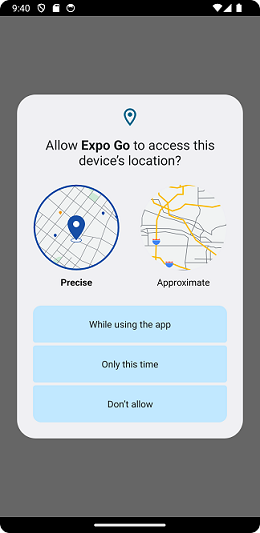Location
The Expo Location (expo-location) allows to read geolocation data from the device (https://docs.expo.dev/versions/latest/sdk/location).
Install the expo-location library
npx expo install expo-location
Import Location to your Component. When using Location we have to check permission (access to geolocation, contacts etc.).
import * as Location from 'expo-location';
export default function App() {
const [location, setLocation] = useState(null); // State where location is saved
useEffect(() => {
// Get location
}, []);
}
Certain functionalities requires users permission. App permissions help support user privacy by protecting access to the restricted data (system state and users' contact informatio, etc.) and restricted actions, such as getting device location and recording audio.
We have to check the permission first using the useEffect() hook. We use the requestForegroundPermissionsAsync() method to check if permission for location usage is granted.
useEffect(() => {
(async () => {
let { status } = await Location.requestForegroundPermissionsAsync();
if (status !== 'granted') {
Alert.alert('No permission to get location')
return;
}
// Get location
})();
}, []);
Now, if you open the app in your device, you will see the permission dialog.

Next, we use the getCurrentPositionAsync(options) method to get user's current location. The options parameter can be used to set desired accuracy, timeout duration, etc. If not provided, default settings will be used.
useEffect(() => {
(async () => {
let { status } = await Location.requestForegroundPermissionsAsync();
if (status !== 'granted') {
Alert.alert('No permission to get location')
return;
}
let location = await Location.getCurrentPositionAsync({});
setLocation(location);
})();
}, []);
The getCurrentPositionAsync() returns an object coords that contains attributes like latitude, longitude, altitude, speed etc.